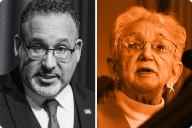You have /5 articles left.
Sign up for a free account or log in.
As college students and faculty hold Black Lives Matter marches and push for social change, some are urging higher education to face a major challenge that’s been unaddressed for too long: far too few Black, Native American and Latinx faculty members work on our nation’s campuses.
Shortages of these faculty members has been a problem for decades, and advocates like me have worked for change for a long time.
Some colleges are finally pledging change and leaning in to the issue. But many others are making only marginal progress on diversity, including some of the research universities producing the largest numbers of Ph.D.s. And the problem remains real.
While about 12 percent of college students in the United States are Black, only about 5.4 percent of full-time faculty members were Black at public four-year colleges and universities in 2017-18. About 4.9 percent of faculty members were Hispanic.
Without action, such disparities will grow worse with projected demographic changes over the next 20 years, with many students learning from faculty members who don’t match the demographics of their classrooms at all.
As states face budget cuts during COVID-19 and after it subsides, the tendency might be to put this off again. Too often, diversity initiatives are the first to fall when times are tight. We need to stop making that mistake. Instead, let’s make this a moment of historic and lasting change in higher education.
A first step would be to foster more underrepresented students of color in pursuing the Ph.D. -- although the fruits of this labor will take a few years to grow.
We can take other immediate steps: improve faculty recruitment and the hiring process to identify more diverse pools of qualified candidates, partner with programs and organizations that help institutions graduate more underrepresented Ph.D. students, and ensure that faculty hiring committees are trained in diversity and dealing with implicit bias.
Most of all, we must improve campus culture so that our institutions are places where people of color feel comfortable learning, teaching, conducting research and leading.
If we don’t seize this opportunity to reconstruct systems that have been unresponsive, unreceptive or hostile for many students and faculty of color, Americans of all colors will suffer the economic and social consequences of this continued neglect.
The time is right -- first because it’s the right thing to do, and also because we’re going to need more professors. By 2026, the U.S. Bureau of Labor Statistics projects, the U.S. will need 13 percent more faculty members than in 2016 -- one of the highest growth rates of any job sector. The data suggest that we’ll need about 17,000 new faculty members each year just to keep pace with retirements and other departures.
Faculty members and students across the country are pushing for more diversity in academe. More than 200 Black faculty members at Georgia State University in Atlanta signed a letter arguing for a more diverse faculty, and leaders are making changes at the state’s largest university, whose more than 54,000 students are among the most diverse in the country.
Students and faculty members at the University of Kentucky also want more faculty diversity. Only about 3.7 percent of the university’s professors are Black, and leaders have promised to address the issue.
Last year, I spoke at a liberal arts college where young white women dominate the student body. And they, too, were demanding more faculty diversity, because they see the value in having a broader range of professors.
But the actions most colleges and universities are taking to address this faculty shortage don’t begin to reflect the urgency of this moment. At the current lumbering rate of increase (0.01 percent per year), it would take more than a century for underrepresented faculty of color to reach parity with the rapidly changing student population.
Helping More Students Finish the Ph.D.
How can states and institutions boost the numbers of underrepresented doctoral students and encourage them to become faculty members?
Research shows that graduate fellowships, leadership development, mentoring and early research opportunities clearly help more students of color prepare for and earn a Ph.D. on time, land a faculty position, and succeed as top-notch professors. It’s worth expanding the leading programs that provide such support: the Alfred P. Sloan Foundation’s Minority Ph.D. Program, the National GEM Consortium, the Mellon Mays Undergraduate Fellowship Program, the McKnight Doctoral Fellowships, the Gates Millennium Scholars, the NSF’s Alliances for Graduate Education and the Professoriate, the PhD Project and the one I lead, the Doctoral Scholars Program at the nonprofit Southern Regional Education Board (SREB).
We know these programs work. They help recruit more students into graduate school, support them while in school and help them graduate more often and faster. SREB scholars, for example, finish their Ph.D.s two years faster on average than Ph.D. students nationally and in about half the average time for Black Ph.D. students, saving up to $120,000 per student.
The annual Institute on Teaching and Mentoring, the nation’s largest gathering of underrepresented doctoral students and faculty members of color -- and the SREB program’s linchpin event -- brings together students and graduates from many of these programs. Most of the more than 10,000 institute attendees over the past 27 years have entered higher education after completing their doctorates.
Last year, an evaluation of the institute funded by the National Science Foundation found that the networking, professional development and leadership opportunities at the institute were essential to most Ph.D. graduates’ academic and professional success.
In 2019, recruiters from about 100 colleges and universities met with prospective faculty from the SREB and similar programs at the institute. What concerns me is that so many colleges and universities don’t seek out these incredible young scholars. Promising minority Ph.D. graduates are left to scramble for positions, even though they bring so much to the campuses they serve and the communities in which they live.
At no major research university, and in no major academic discipline, are Black, Hispanic or Native American faculty overrepresented. Not one. Is it any wonder, then, that many students of color feel unseen and unheard? The same goes for faculty members whom I’ve heard describe the feelings of isolation and even outright resistance to their presence.
It’s time to make definitive change. We know what works, and the costs are relatively small. Without great expense, states, higher education systems and universities can double or triple their investments in programs that help underrepresented graduate students of color through the Ph.D. and into faculty positions.
Colleges and universities need to improve their recruiting and retention practices so that institutions become places where nonwhite faculty members feel welcome and stay and thrive. They should build on the momentum of 2020’s racial justice movement to examine and change institutional culture to eliminate the systemic barriers and isolation felt by many students and faculty of color.
We can’t let this moment pass without action. We don’t have the time or talent to waste.







